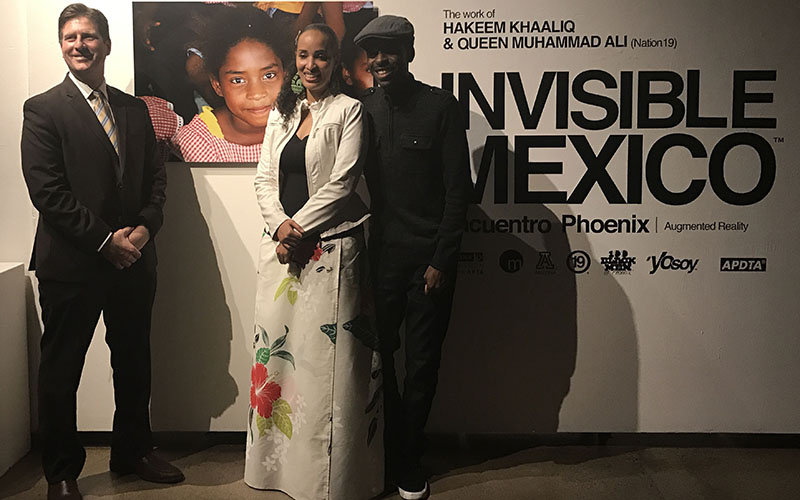
Phoenix Mayor Greg Stanton (left) poses with “Invisible Mexico” artists Queen Muhammad Ali and Hakeem Khaaliq for the opening night of the exhibition on Thursday, March 2, 2017. (Photo by Ryan Santistevan/Cronkite News)
PHOENIX – A new exhibit by the award-winning team of Hakeem Khaaliq and Queen Muhammad Ali that showcases isolated descendants of African natives who settled in Mexico is on display at the monOrchid gallery in downtown Phoenix’s Roosevelt Row.
The husband-and-wife team spent the past 10 years creating “Invisible Mexico (Encuentro Mexico)” by documenting the lives of isolated descendants of the African diaspora in Mexico through a collection of augmented photographs shot in Central America, according to its press release.
The display, which is available until March 31, has been identified as Arizona’s first augmented-reality exhibit featuring anthropology, the study of human societies and their culture, the release said.
On a recent night, visitors to the gallery could be seen using the Blippar app to use the augmented-reality feature by holding their phones up to the portraits of the people who reside on the country’s rural Pacific and Gulf coasts and are referred to as Afro-Mexicanos.
Queen Muhammad Ali said the augmented-reality exhibit was born from the two traveling to Mexico and accumulating a collection of photos and video. She said during a visit to the University of Arizona, they met Bryan Carter, an associate professor of Africana studies, who showed them a similar project he had produced with his students in Paris. The two then collaborated to make “Invisible Mexico.”
She said the exhibit’s name “Invisible Mexico” is a reference to the people who were basically invisible until 2015, when they were finally accepted as a group of people in Mexico.
“Unfortunately a lot of them were very, very shy to the camera due to a low self esteem,” Muhammad Ali said. “It was very hard to capture but finally they warmed up to us after the many times we returned.”
The couple recently came to Phoenix from their feature at the Museum of Modern Art in New York as part of Doc Fortnight, 2017 — MoMA’s International Festival of Nonfiction Film and Media. Their documentary short, #Bars4 Justice, put into view the new civil rights movement through hip-hop in Ferguson, Missouri.
The two also run a magazine out of Deer Valley called Nation19. Its product is a blend of hip-hop culture, photojournalism and anthropology.
Nation19 produces a printed magazine, documentary films and hosts exhibits based on various articles featured in the magazine.
Khaaliq said he appreciated the Arizona Commission on the Arts, 100 Black Men of Phoenix and YoSoy for sponsoring the event. He said the exhibit was meant to bring the community together.
“It’s important that we put down religious, race, culture and just meet together on a higher frequency,” Khaaliq said. “Love and those things are important. That’s what art connects people to.”
Phoenix Mayor Greg Stanton attended the gallery and said it consisted of three of his favorite things — support for local artists, art that educates and support for the monOrchid.
Stanton said the particular exhibit is special because of the relationship with Mexico. He said in his five years as mayor he has been there 16 times, but it doesn’t compare with the 40 times Khaaliq and Muhammad Ali have gone there in the 10 years for this project.
“That’s why artwork like this, which will make Phoenicians have an appreciation for Mexico, a side of Mexico that they were not aware of, a side of Mexico I was not aware of,” Stanton said. “You’ve educated me here tonight and because of this exhibit and the technology that you’re using to tell that story … you are going to bring the people of Phoenix closer to the people of Mexico and that is nothing but a good thing.”
From living on remote islands in the South Pacific to producing the untold history of blacks in Mexico, Khaaliq and Muhammad Ali hope to use their documentary film-making through interactive storytelling to raise awareness on global issues.
“I want (visitors) to be able to enjoy and appreciate the people that were not counted in the sense that they were never talked about,” Muhammad Ali said. “I want them to learn something about a shared culture that Latino and Hispanic people have with the black community and be able to share that.”